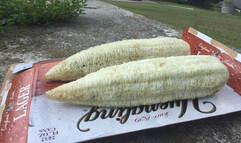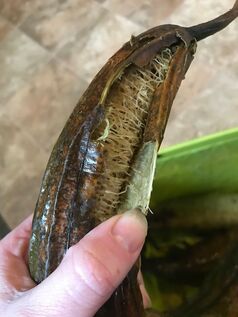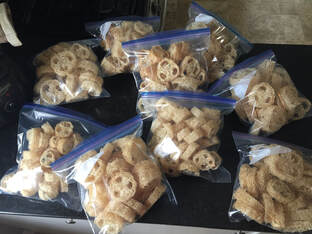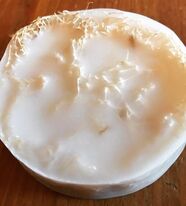 Still interested in luffas after all that? Read on for Part II of Luffa 101. (Find Part I here.) Whether your luffas dry indoors or out on the vine, you now have to get beneath that skin to actually see or use the actual luffa sponge. So, you’ve got to peel it. And it’s tough! And it’s time consuming! And then I realized it’s a whooooole lot easier if you soak them first.  I know, soaking them seems counter intuitive after we just spent all this time drying them, but trust me it’s different this time. Just fill a bucket/large pot/bathtub/whatever with water (warm is probably better, for the sake of your hands that will be peeling them). Let them sit for a bit, and they’ll be much easier to peel. They’ve got stringy spines that zip off and can sometimes make the peeling easier (or at least more satisfying). Soon, you’ll have the skeleton revealed and the perfect home grown luffa you’ve always dreamed of.  From here, I typically give them a quick dip in a mold-preventing solution, then let them dry out once more. I slice them for use in soap, but they can be used whole in the bath. Oh, and be prepared for seeds. Especially if you slice them, there are going to be so many seeds. It’s up to you if you want to try to remove them. So in summary and full disclosure, growing luffas (especially in a cool climate) is kind of a giant pain. Some home gardeners appreciate the novelty, but most who've tried it don't seem to go for a second season.  For us though here at Thirsty Boot Farms, we plan to keep growing them. What can I say, small businesses thrive on novelty. I myself am addicted to the exfoliating qualities in the soaps we make. Plus it's a fun word to say. Luffa. Luuuu-ffa. Hehe. I even had the wild idea that I might try to cultivate my own variety of cold-hardy luffa. I bought and read a book on plant breeding techniques only to realize that in simply saving seeds from my successful luffas and replanting them next year, I was already selectively breeding for cold(er)-hardy luffas. So that's pretty cool.
1 Comment
|
AuthorErin runs the blog for Thirsty Boot Farms. Archives
March 2022
Categories |
 RSS Feed
RSS Feed
